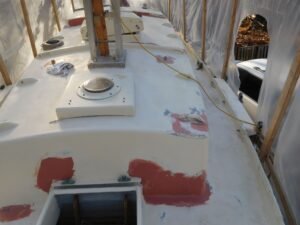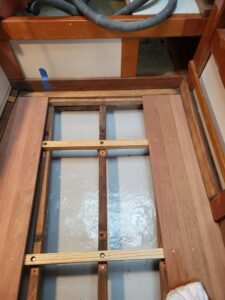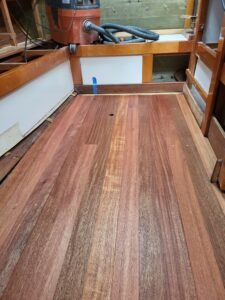For the enthusiastic boater, that last little bit of autumn when the daytime temperature still gets above fifty degrees is always a rush. As long as paint, resin, varnish, or fairing compound will cure, it’s a great time to get a head start on things so that next spring the launch can be earlier, or at least less frantic. I mentioned, last post, the stay’sl chainplates I made; what I didn’t mention was that while I was carving up the topsides to put those in, it seemed a good time to chase out some hairline cracks in the finish here and there as well.

As everyone knows, there’s usually a whole empire of delamination under the innocent-looking hairline, and I was determined to chase it all back to the source and root it out. When I built Ganymede, outside in all weathers in California, I didn’t always have ideal conditions, and some of the fairing compound, applied in blistering heat, had begun to separate from the underlying fiberglass after twelve years of hard sailing.
It was a long and dusty road with angle and die grinders, sanders, even a Dremel tool, to excavate all the cracking. It was gratifying, though, to find that it was confined to cosmetic layers, and the structure of the boat remained solid. In order to avoid thick layers of fairing compound that might just crack again in future, I laminated scraps of biaxial and woven cloth into the ground-out hollows before smearing fairing compound over. This same strategy worked on the transom, where I patched a dozen-odd obsolete bolt holes with thickened resin and a patch of glass at either end.

Where normally I would have used Poly-fair, an MEKP-catalized polyester fairing compound, I sprang for the epoxy-based Awl-fair instead. While considerably cheaper, I’ve had the Poly-fair blister in the sun after being in the water; it’s not really meant for finish-fairing, but more for making plugs and molds, at which it excels. Given that the primer used on the decks is epoxy-based, it seemed good to keep the fairing compound within the same system. Another advantage of Awl-fair is that it has a long working life, so you can mix up a big batch and still have time to smear carefully without its “going off” untimely.

But even the best fairing compounds require certain temperatures to adhere well, and as the golden autumn passed into bitter winter, the deck project had to be deferred until the spring rush. Now, the inside of the boat can’t be made much warmer than the outside just now, with all the portholes out until the cabin is painted, but the only limit to carpentry is how much cold the carpenter can endure.
In my case, that’s not much, but by taking it in short chunks, I’ve managed to install the new cabin sole. The old one, gray with the patina of years of sweaty feet, had never pleased Danielle. It was a design idea that didn’t pan out, you see: I had left narrow gaps between the planks, with the idea that any water that dripped off of foulies or spilled from the table would quickly trickle through to the bilge and never puddle on the sole. This aspect worked fine, but the unintended consequence was that all the dust and chips and crumbs and assorted grit that might have been swept up gathered instead in those cracks, and was very hard to clean out.

Conceding her point, I made instead an impenetrable sole out of African mahogany, with panels edge-glued so they’re a solid piece, resting on some new white ash sole bearers. I might have kept with the boat’s theme of douglas fir, but the sort of fir they had at Home Depot in California where I built the boat is not available here, and African mahogany is.
Besides, the same paucity of fir is forcing me to replace the cabinetry around the stay’sl chainplate bulkhead with cherry—again, the choice was made because I had a bunch of cherry lying around from a friend’s cut-down tree—so the theme of the visible woodwork is changing anyway.

Feeling that it would have been a shame to waste all those years of foot-sweat patina though, I cut down the old cabin sole planks into solid panels to replace the grating in the aft cabin, with was also a grit-collector. So the original wood still abides, just re-purposed to another place.
And so winter wears on, with projects sneaked in here and there as time and weather allow, all to make that mad spring rush just a little bit easier, and ultimately for the ineffable satisfaction of hoisting the mainsail on a sunny summer day, and as the boat gathers way and takes a bone in her teeth, knowing that this work was worth it and then some.